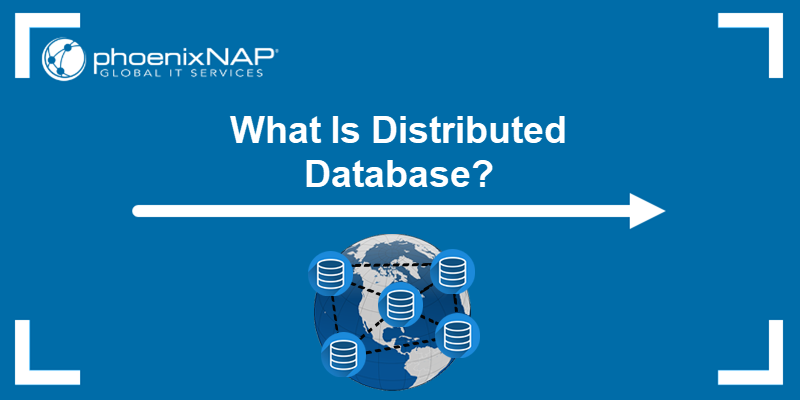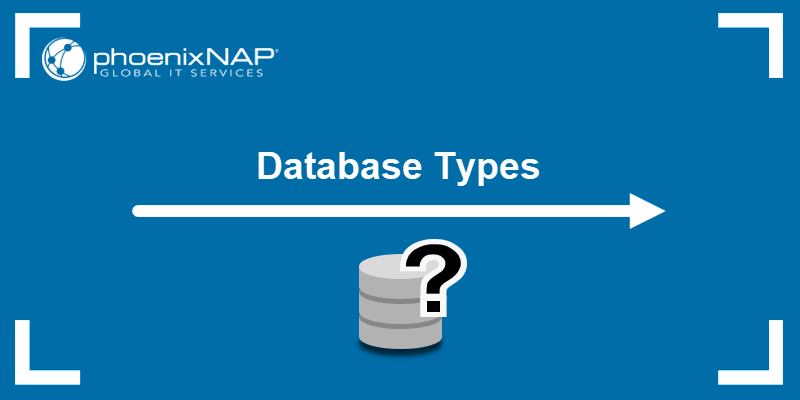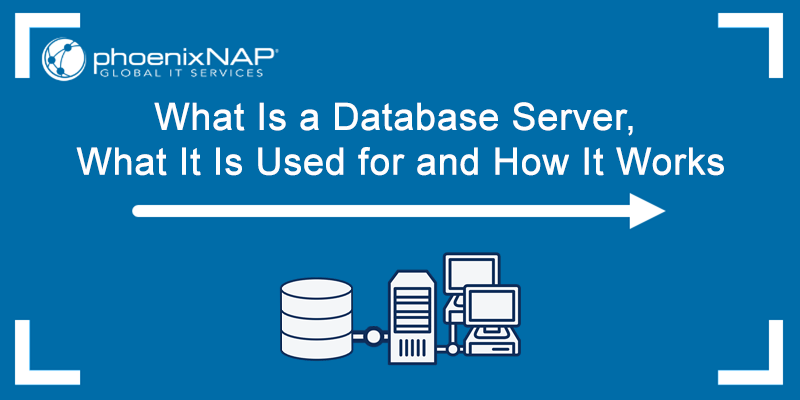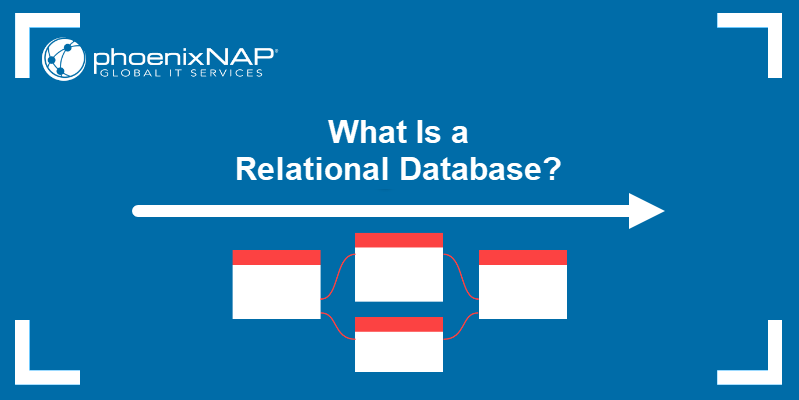One of the greatest threats to modern databases is data loss due to hardware failure or ransomware. Distributed databases offer a solution by replicating data in different physical locations.
Database replication allows to distribute parts of a database across multiple nodes.
In this tutorial, we will cover how data replication works, when to use it, different replication types and schemes, and tools that help replicate a database.
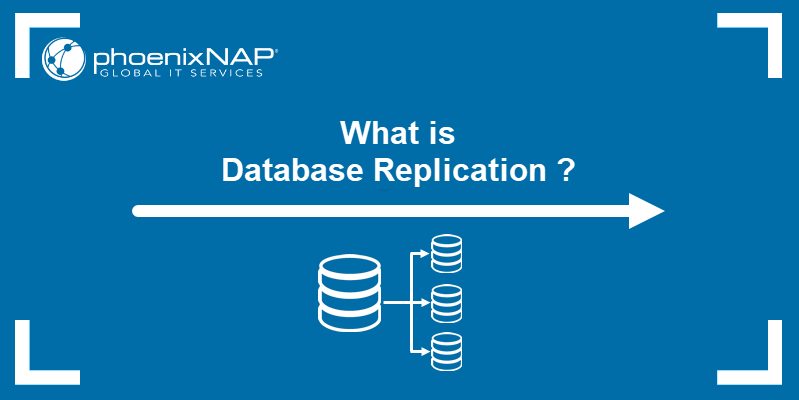
What Is Database Replication?
Database replication is the process of copying data and storing it in different locations. Performing data replication ensures there is a consistent copy of the database across all the nodes in a distributed system. This serves to make the data widely available and protect from data loss.
The replicated data can be a full or partial snapshot and it can be stored on-site, off-site, or in a cloud environment. In case of downtime, organizations recover data and maintain business continuity by restoring from a backup location.
Note: 90% of businesses without a disaster recovery plan close after a major disruption. Eliminate this risk with industry-leading Disaster-Recovery-as-a-Service (DRaaS) solutions.
Data is replicated either synchronously or asynchronously:
- Synchronous replication. Data is written simultaneously to the primary database and all its replicas.
- Asynchronous replication. Data is written to the primary database first and then copied to the replicas later.
Database Replication Types
There are several different methods to replicate a database. Organizations should choose a technique based on the purpose of the replicated data and how they intend to access it.
Snapshot Replication
Snapshot replication copies a "snapshot" of the database - precisely as it appears the moment the replication process starts. It does not monitor for changes or updates to the data.
Snapshot replication is useful when the data doesn't change frequently, but also if there are significant changes over a short time. Any change to the database makes a snapshot outdated until a new one is replicated.
Note: Snapshots and backups are not mutually exclusive. Read up on the main concepts and differences between these two solutions in our post Snapshot vs Backup.
Transactional Replication
Transactional replication creates a full copy of the database, with new data coming in as the database changes. Data is copied in real-time in the order of changes made, which ensures consistency.
It is best to use transactional replication for ensuring incremental, real-time changes to data. This improves performance and decreases latency while providing a high volume of read, write, and delete activity.
Merge Replication
Merge replication combines data from several sources into a single database. Using merge replication allows multiple users to change the data and have all the changes applied to the new replica.
Merge replication helps quickly discover and address conflicting changes. It also allows users to make changes offline before synchronizing with the server.
Heterogeneous Replication
Heterogenous replication is used to replicate data between servers supplied by different vendors. For instance, it allows you to copy data from an SQL server to a non-SQL server.
Peer-to-Peer Transactional Replication
Peer-to-peer replication is based on transactional replication. It allows all participating users and servers to send data to each other so that the updates happen in near real-time.
Peer-to-peer replication is especially useful for web applications. Its flexibility helps scale the number of users without affecting performance. It also makes the system more robust, allowing servers to shut off for maintenance.
Note: Refer to our article Backup vs Replication to learn about the main differences and benefits.
Database Replication Schemes
The following replication schemes are used for database replication:
Full Replication
Performing a full replication means copying the complete database to every node of the distributed system. This approach maximizes data redundancy, increases global performance and data availability. Data is available as long as one node is functional.
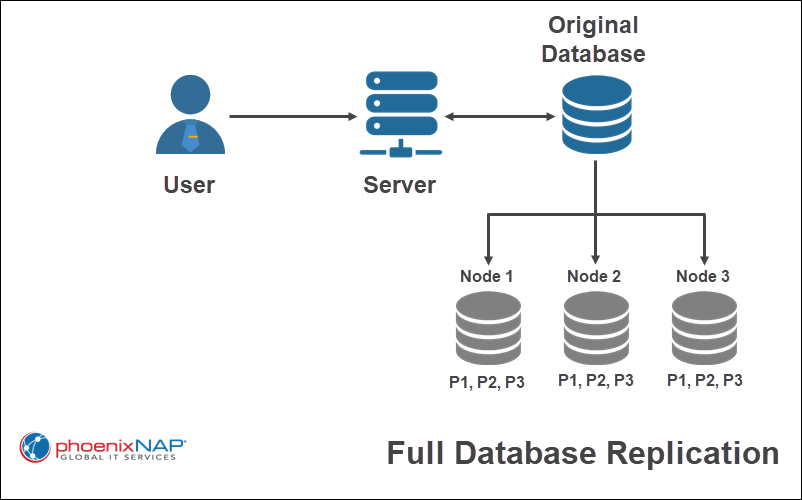
In the example above, all parts of the original database (P1, P2, P3) are fully replicated to all sites.
Full replication takes longer to perform as the update needs to be replicated to all sites. Furthermore, the costs of storing full data snapshots at multiple locations can add up.
Partial Replication
Copying only certain parts of a database is partial replication. This is usually decided by how important it is to have the data available at each location.
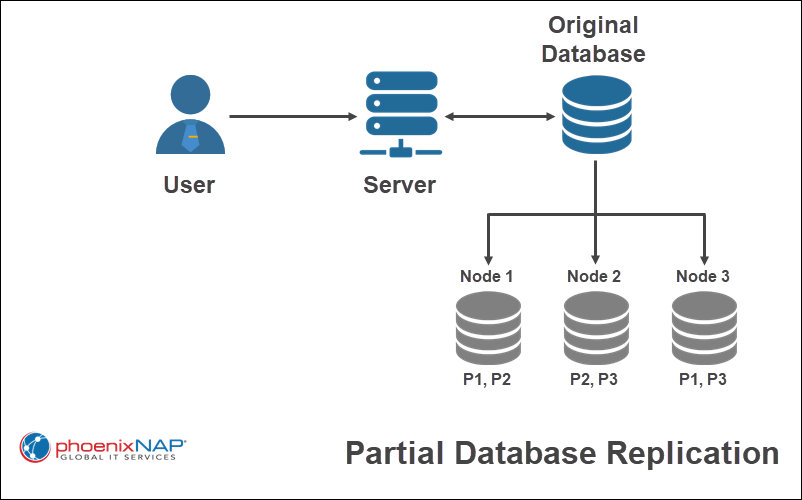
In the example above, only certain parts of the original database (P1, P2, P3) are replicated to a single node.
When using a partial replication scheme, the number of copies for each part of the database can range from one to the number of total nodes in the distributed system.
No Replication
With no replication, each node in a distributed system only receives a copy of one part of the database. This replication scheme is the fastest to perform, but it tends to lower data availability and leaves the database vulnerable to data loss. However, concurrency is easy to achieve.
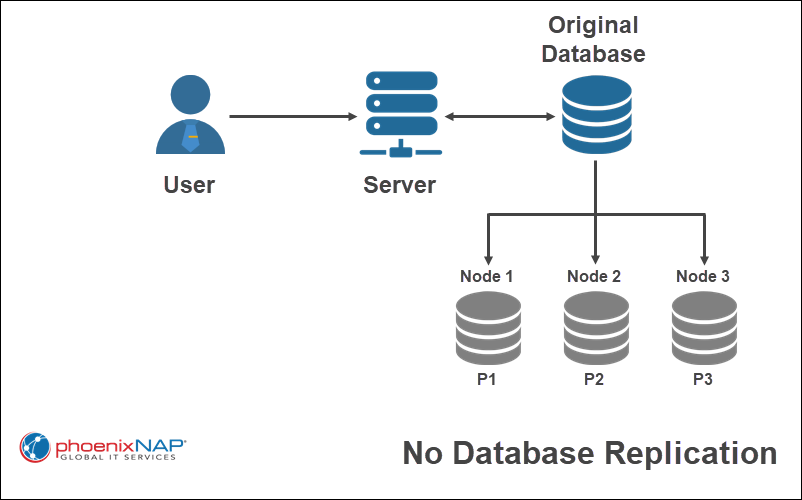
In the example above, only a single fragment of the original database is replicated to a specific node.
Database Replication Software and Tools
Many database management tools offer ways to perform database replication. There are also third-party replication tools that provide the same features.
Third-party tools may even be more flexible since most allow you to replicate across multiple types of databases. Here are some of the most popular examples:
- phoenixNAP Data Backup and Restore. phoenixNAP offers multiple backup options and solutions, including Veeam integration, cloud database backup, managed backup for Office 365, and DRaaS (Disaster Recovery as a Service).
- Veeam Backup & Replication. Veeam works with different types of databases, including cloud databases, virtual, Kubernetes, and physical distributions. It offers continuous data protection, advanced replication and failover for disaster recovery, and instant recovery for popular database managers, such as NAS, Microsoft SQL, and Oracle.
- Acronis Cyber Backup. Acronis supports over 20 database platforms and offers advanced security features, such as AI-based ransomware prevention.
- NAKIVO Backup & Replication. NAKIVO offers features like support for live apps, file and object-level recovery, global deduplication, and automatic reports. It can replicate data locally, on a remote server, or in the cloud.
- Carbonite Safe Backup. Carbonite is geared towards smaller businesses. It offers automatic cloud and hard drive backup, image backup and bare-metal restore, and database replication at higher tiers.
Note: Learn everything you need to know about disaster recovery, the types and how it works in our post What is Disaster Recovery?
Advantages of Data Replication
Using database replication helps:
- Ensure business continuity with a Disaster Recovery Plan. In case of hardware failure or a ransomware attack, having data replication as part of your disaster recovery plan ensures there's an off-site copy of the system. That enables organizations to restore data and maintain business continuity.
- Improve performance. Having the same data in multiple locations means a user can retrieve data from the nearest server, reducing network latency and increasing performance.
- Improve multi-user support. Data replication helps with query execution, especially when multiple users are accessing the database.
- Improve analytics. Having a separate, complete copy of a database allows a team to perform analytics without affecting performance.
- Improve availability. Several users can access and manage data in a distributed database without getting in each other's way.
Disadvantages of Data Replication
Data replication poses several challenges:
- It can require a lot of storage space, especially for full replications. This can create high costs or reduce performance if many replicas need to be updated simultaneously.
- Maintaining data consistency is difficult when using methods like merge or peer-to-peer replication.
Conclusion
After reading this article, you should have a solid knowledge of what database replication is and all the methods and replication schemes you can use to perform one.
You should also have a good starting point for choosing a database replication solution that will provide an easy and effective way to replicate data.
